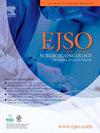肌少性肥胖对胃癌患者术后并发症及长期生存的影响
IF 2.9
2区 医学
Q2 ONCOLOGY
引用次数: 0
摘要
背景:肌少性肥胖(SO),定义为肌少症(低肌肉量和功能受损)和肥胖的共存,与几种癌症的不良结局有关,但其对胃癌(GC)的影响尚不清楚。方法回顾性队列研究包括502例行根治性胃切除术的胃癌患者。通过术前CT在L3椎体水平评估体成分。SO在概念上是肌肉减少(肌肉质量低且功能受损)和肥胖的共存;在该队列中,由于缺乏功能测试,SO在手术上被定义为低骨骼肌指数(SMI)加高内脏脂肪面积(VFA)。将患者分为四组:正常成分组、肥胖组、肌肉减少组和SO组,以正常成分组为参照。通过logistic和Cox回归评估并发症、总生存期(OS)和无病生存期(DFS)。结果16.9%的患者存在so。中位随访时间为40个月(四分位数间距[IQR]: 20-65个月),估计5年OS为45%。与正常组相比,SO与较高的术后并发症发生率(优势比[OR] = 2.63, 95% CI: 1.91-4.90, P = 0.002)、较差的OS(风险比[HR] = 1.88, 95% CI: 1.32-2.67, P < 0.001)和较差的DFS (HR = 1.75, 95% CI: 1.22-2.51, P = 0.002)独立相关。SO在预测不良后果方面优于单纯的肌肉减少症或肥胖。结论so是胃癌的独立预后因素,应纳入术前评估。针对SO的早期干预策略可能有助于改善术后和生存结果。本文章由计算机程序翻译,如有差异,请以英文原文为准。
Impact of sarcopenic obesity on postoperative complications and long-term survival in patients with gastric cancer
Background
Sarcopenic obesity (SO), defined as the coexistence of sarcopenia (low muscle mass with impaired function) and obesity, has been linked to adverse outcomes in several cancers, but its impact in gastric cancer (GC) remains unclear.
Methods
This retrospective cohort study included 502 GC patients who underwent curative gastrectomy. Body composition was assessed via preoperative CT at the L3 vertebral level. SO is conceptually the coexistence of sarcopenia-low muscle mass with impaired function-and obesity; in this cohort, lacking function tests, SO was operationally defined as low skeletal muscle index (SMI) plus high visceral fat area (VFA). Patients were categorized into four groups: normal composition, obesity, sarcopenia, and SO, with the normal composition group serving as the reference. Complications, overall survival (OS), and disease-free survival (DFS) were assessed via logistic and Cox regression.
Results
SO was present in 16.9 % of patients. The median follow-up time was 40 months (interquartile range [IQR]: 20–65 months), and the estimated 5-year OS was 45 %. Compared with the normal composition group, SO was independently associated with higher rates of postoperative complications (odds ratio [OR] = 2.63, 95 % CI: 1.91–4.90, P = 0.002), worse OS (hazard ratio [HR] = 1.88, 95 % CI: 1.32–2.67, P < 0.001), and poorer DFS (HR = 1.75, 95 % CI: 1.22–2.51, P = 0.002). SO outperformed sarcopenia or obesity alone in predicting adverse outcomes.
Conclusions
SO is an independent prognostic factor in GC and should be incorporated into preoperative evaluation. Early intervention strategies targeting SO may help improve postoperative and survival outcomes.
求助全文
通过发布文献求助,成功后即可免费获取论文全文。
去求助
来源期刊

Ejso
医学-外科
CiteScore
6.40
自引率
2.60%
发文量
1148
审稿时长
41 days
期刊介绍:
JSO - European Journal of Surgical Oncology ("the Journal of Cancer Surgery") is the Official Journal of the European Society of Surgical Oncology and BASO ~ the Association for Cancer Surgery.
The EJSO aims to advance surgical oncology research and practice through the publication of original research articles, review articles, editorials, debates and correspondence.
 求助内容:
求助内容: 应助结果提醒方式:
应助结果提醒方式:


